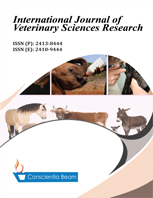Prevalence of Ketosis Detected by an Electronic Cow Side Test and its Impact to Days Open on Dairy Cows
DOI:
https://doi.org/10.18488/journal.110.2021.62.14.18Abstract
The study aimed to resolve and confirm the previous results of subclinical and clinical ketosis prevalence in northwestern Croatia detected by an electronic cow side test and its impact on days open in dairy herds. Cows (N=559) 2-8 years old from 96 farms located in northwestern Croatia were included in the study. The average milk yield was 7327.80 ± 968.21 kg. The cows were classified into two separate groups: ketotic cows group KET (n=73) with BHBA blood concentration of ≥1.4 mmol/L, and negative NEG (n=486) group with serum BHBA level of <1.4 mmol/L. One droplet of blood from the caudal vein was collect from randomly selected cows in the period 7 to 15 days after parturition. BHBA level determined with Precision Xceed BHBA devices. The period from parturition to first insemination (days open to the first (artificial) insemination, DOFI) was shorter in NEG than in the POS group (110.56±10.65 days vs.114.82±12.23 days, respectively) such as period from parturition to successful conception (days open to successful conception, DOSC), (139.97±15.18 days vs. 127.99±15.87 days, respectively). The prevalence of clinical and subclinical ketosis was 15.02%. Ketosis significantly prolonged days open to first artificial insemination and days open to successful conception in cows from northwestern Croatia.

